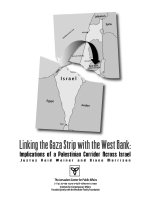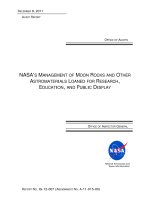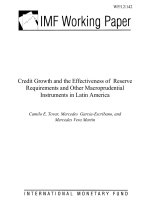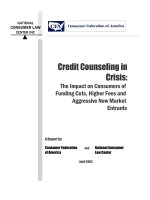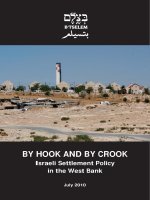THE HUMANITARIAN IMPACT ON PALESTINIANS OF ISRAELI SETTLEMENTS AND OTHER INFRASTRUCTURE IN THE WEST BANK doc
Bạn đang xem bản rút gọn của tài liệu. Xem và tải ngay bản đầy đủ của tài liệu tại đây (22.74 MB, 150 trang )
THE HUMANITARIAN
IMPACT ON PALESTINIANS
OF ISRAELI SETTLEMENTS
AND OTHER INFRASTRUCTURE
IN THE WEST BANK
July 2007
United Nations - Office for the Coordination of Humanitarian Affairs (OCHA)
THE HUMANITARIAN
IMPACT ON PALESTINIANS
OF ISRAELI SETTLEMENTS
AND OTHER INFRASTRUCTURE
IN THE WEST BANK
July 2007
United Nations - Office for the Coordination of Humanitarian Affairs (OCHA)
4
Table of Contents
Pages
Introduction
9
Chapter One
_
Israeli settlements and other infrastructure in the West Bank
11
Israeli settlements in the West Bank
12
What is a settlement?
13
Where are settlements located?
15
Settlements: territorial and population expansion
16
Inset 1 - The four fastest growing settlements
21
Case study - The establisment and expansion of Har Homa settlement
30
Who are the settlers?
32
Case study - Financial incentives: housing in settlements and in Israel
33
The establishment and location of outposts
34
Israeli agriculture in the West Bank
40
Military infrastructure in the West Bank
42
Natures reserves in the West Bank
44
The Barrier and the creation of 'closed areas' in the northern West Bank
46
Chapter Two
_
Settlements, roads, closures - Palestinian enclaves
57
A road network primarily for Israeli use
58
Bypass road network
62
Major and regional road network
60
Physical components of the closure regime
64
West Bank closures: creating a two-tier network
68
Connecting enclaves
72
Fragmenting the West Bank into Palestinian enclaves
70
5
Pages
Chapter Three
_
Settlements and Palestinian urban centres
75
East Jerusalem
77
The isolation of East Jerusalem
78
Palestinian access to East Jerusalem
82
Case study - Palestinian access to hospitals in East Jerusalem
86
Nablus, an encircled city
89
Hebron City
95
Chapter Four
_
Settlements and Palestinian rural centres
103
Access to jobs and markets
104
Focus on the Jordan Valley
105
Case study - Al Jiftlik village: development inhibited
106
The Barrier separates Palestinian communities from their land
110
Case study - Jayyus village
112
Access to water
114
Settlements and conflict over resources
116
Case study - Southern Hebon, Masafer Yatta
117
Conclusion
121
Annex 1 - Israeli settlements under International law
127
Annex 2 - Israeli presence in the West Bank geo-database: feature definitions,
geographical data and sources
133
Annex 3 - Governorate map and source of other geographical data
146
Access to agricultural land
105
6
Table of Maps
Pages
Settlement outer limits in 1987
18
Closures block access to Hebron
98
Closed military areas
43
Natures reserves
45
The route of the Barrier
47
Actual and projected land west of the Barrier
51
Roads primarily for Israeli use
59
Connection of roads primarily for Israeli use in the southern West Bank to major roads in Israel
61
Old versus new Road 60 - an example of bypassing Palestinian communities in the southern West Bank
63
Palestinian enclaves in the West Bank
71
Location of the closures
69
Palestinian movement between enclaves
73
Palestinian communities and access to East Jerusalem
85
Settlement outer limits in 2005
19
Ariel settlement expansion: 1987 - 2005
23
Newe Ya'akov / Pisgat Ze'ev settlement expansion: 1987 - 2005
25
Ma'ale Adumim settlement expansion: 1987 - 2005
27
Betar Illit settlement expansion: 1987 - 2005
29
Har Homa area of expansion - as of May 2006
31
Outpost outer limits in 2005
37
The connection between Shilo and Eli settlements and their outposts
39
Israeli land cultivation in 2005
41
The narrowing of the West Bank for Palestinian use
53
Expansion of settlements in East Jerusalem 1987 - 2005
79
Jerusalem settlements and the route of the Barrier
83
Specialist hospitals in East Jerusalem
87
Checkpoints and other physical obstacles surrounding Nablus city
91
Israeli settlements inside the Old Suq
99
Location of Al Jiftlik village
107
Al Jiftlik, a village encircled by Israeli measures
109
Jayyus village lands and water resources cut off by the Barrier
113
Oslo agreements: Area A, B and C
122
Palestinian enclaves in the West Bank
123
Palestinian enclaves in the regional context
125
The impact of closures - Sa’ir village example
67
7
Table of Graphs
Pages
Year and number of settlements in the West Bank, including East Jerusalem
16
Expansion of Israeli settler population in the West Bank, including East Jerusalem
20
Ariel settlement growth: population and land area covered since 1987
22
Ma'ale Adumim settlement growth: population and land area covered since 1987
26
Betar Illit settlement growth: population and land area covered since 1987
28
The establishment of outposts in the West Bank
35
The connection between settlements and outposts in the northern West Bank
38
Proximity of outposts to 'mother settlements' in the West Bank
36
The location of West Bank settlements in relation to the Barrier
50
Settlement expansion in East Jerusalem (1987 - 2004/5)
80
Newe Ya'akov / Pisgat Ze'ev settlements' growth: population and land area covered since 1987
24
Type of roads primarily for Israeli use
59
The number of obstacles in the West Bank since 2003
66
Expansion of Israeli settler population in Pisgat Ze'ev
80
Consumer Price Index (CPI) for transportation and communication in the West Bank
104
Most populated Israeli settlements by governorate in 2004
15
8
The settlement of Betar Illit in Bethlehem governorate (see map of Palestinian governorates, p. 146), the most rapidly growing settlement in the West Bank (see inset
p.29). Photo by J.C Tordai, 2007.
Introduction
This report examines the humanitarian
impact on Palestinians from the ongoing
construction of settlements in the West
Bank and other Israeli infrastructure,
such as the Barrier and the roads that
accompany them.
The analysis shows that almost 40% of
the West Bank is now taken up by Israeli
infrastructure. It also demonstrates how
roads linking settlements to Israel, in
conjunction with an extensive system
of checkpoints and roadblocks, have
fragmented Palestinian communities from
each other.
The deterioration of socio-economic
conditions in the West Bank has been
detailed in regular OCHA and World Bank
reports over the last several years. These
have underlined the fact that freedom of
movement for Palestinians is crucial to
improving humanitarian conditions and
reviving socio-economic life.
Introduction
8
The findings are based on extensive
fieldwork combined with spatial analysis
derived from satellite imagery.
1
As the
maps illustrate, the consequences of
settlements and related infrastructure
on Palestinian life are severe, and
if current trends continue, socio-
economic conditions in the West Bank
are likely to worsen.
Despite the transfer of Israeli civilians
into occupied Palestinian territory
(oPt) being illegal under international
law, the Israeli settler population in the
West Bank settlements has continued
to grow steadily by around 5.5% each
year. In 2007, approximately 450,000
settlers
2
live in the West Bank, including
East Jerusalem, alongside 2.4 million
Palestinians.
More than 38% of the West Bank
now consists of settlements, outposts,
military bases and closed military areas,
Israeli declared nature reserves or other
related infrastructure that are off-limits
or tightly controlled to Palestinians. The
settlements and other infrastructure
are detailed in Chapter One.
The settlements are linked to each
other and to Israel by an extensive
road network. Palestinians for the most
part are either prevented from using
these roads or have only restricted
access onto them. The roads and their
restrictions on Palestinian movement
are outlined in Chapter Two.
The West Bank has been dissected into
dozens of enclaves by the settlements
and related infrastructure. This
fragmentation has negatively affected
social and economic life for the vast
proportion of Palestinians. Chapters
Three and Four examine the impact
of these restrictions in both urban and
rural settings.
Palestinians compete with Israeli settlers
for West Bank resources, notably limited
land and water, while their freedom of
access and movement is denied. These
issues, which are directly related to
Israeli settlements and infrastructure,
are detailed in the concluding chapter.
The Israeli settlement of Pesagot is located in Ramallah governorate with a 2004 population of approximately 1,380. Photo by J.C. Tordai, 2007.
Introduction
9
1.
OCHA has created a geo-database of Israeli presence in the West Bank drawing together a variety of primary resources including satellite
imagery, Israeli topographical maps (Survey of Israel), available Israeli Central Bureau of Statistics data (ICBS) and Palestinian Ministry of
Planning data. For more details related to methodology please refer to Annex 2.
2.
According to the Israeli movement Peace Now ( However, throughout this report
OCHA cites 2004 population data for the number of Israeli settlers living in the West Bank as this is the most current available data at the
time the research and writing of this present document were conducted. See Annex 2 for more details about demographic data contained
in this report.
Endnotes
Introduction
10
Israeli settlements and other infrastructure in the West Bank
This chapter examines the variety and
extent of Israel’s physical control over
land and resources in the West Bank,
including East Jerusalem.
1
It details the
establishment and expansion of Israeli
settlements and other infrastructure,
including closed military areas, nature
reserves and the West Bank Barrier.
Chapter One
Settlements and other infrastructure in the West Bank
12
Settling an occupied territory is illegal
under international law. By its very
nature, military occupation is seen
as temporary. The Fourth Geneva
Convention explicitly prohibits
the transfer of the Occupying
Power’s civilian population into the
territory it occupies since such
settlement makes terminating the
occupation more difficult.
4
The illegal
status of Israeli settlements has been
confirmed by the United Nations (UN)
Security Council and the International
Court of Justice (ICJ) (see Annex 1)
Israeli settlement construction in the
West Bank has taken place under every
government since the beginning of
Israel’s occupation following the 1967
Arab-Israeli War.
2
In 2007, there are
more than 450,000 settlers living in 149
settlements in the West Bank including
East Jerusalem.
3
Ofra settlement, established in 1975, is located along Road 60 in Ramallah governorate (population over 2,260 settlers). Photo by J.C. Tordai, 2007.
Israeli settlements in the West Bank
Chapter One
13
Settlements are organised communities
of Israeli civilians established on land
in the occupied West Bank, including
East Jerusalem, with the approval
and direct or indirect support of the
Israeli government. Apart from a few
exceptions in East Jerusalem, residence in
these communities is not open to West
Bank and East Jerusalem Palestinians but
only to Israeli citizens and to persons
of Jewish descent entitled to Israeli
citizenship or residency under the Law
of Return.
There are 149 settlements in the
West Bank including East Jerusalem. In
addition, there are nine industrial sites
which are Israeli owned and operated
and located near settlements, usually
within their municipal boundaries.
5
These are often managed from
nearby settlements and include Israeli
industrial companies.
6
consist of residential areas, shopping centres and schools that make up the urban
fabric of settler communities. This urban area is served by roads and industrial
infrastructure to provide power, water and other services.
the area beyond the urban fabric. The large majority of settlements are
surrounded by a track, a road and/or a fence that determines a settlement’s
‘outer limits’ or current physical boundaries.
• ‘outer limits perimeter’:
The territory controlled by settlements can be divided into two:
What is a settlement?
• ‘built-up areas’:
Dolev settlement - Ramallah governorate
Dolev settlement - Ramallah governorate
Dolev settlement - Ramallah governorate
Dolev settlement - Ramallah governorate
For more details, see Annex 2 pp.134-135.
For more details, see Annex 2 pp.134-135.
Settlements and other infrastructure in the West Bank
14
The surrounding fence of the large Ariel settlement in the northern West Bank (Salfit governorate). Photo by OCHA / Nir Kafri, 2007.
The surrounding fence of the Efrata settlement in the central West Bank (Bethlehem governorate). Photo by OCHA / Steve Sabella, 2005.
Chapter One
15
In 2007, approximately 57% of the total
settler population in the West Bank
lived within a 10 kilometre radius of the
Old City of Jerusalem, many of them
inside the Israeli declared Jerusalem
municipal boundary.
7
The encircling
settlements have increasingly isolated
East Jerusalem, home to approximately
250,000 Palestinians, from the rest of
the West Bank (see Chapter Three).
Eighty per cent of the settler population
lives within a 25 kilometre radius
of Jerusalem in the Ramallah and
Bethlehem governorates.
8
Most of the settlements deeper into
the central West Bank are located on
hilltops affording them a commanding
presence over surrounding Palestinian
communities. Other settlements,
such as those in the Jordan Valley, have
large areas of agricultural land under
their control (see Chapter Four).
Where are settlements located?
Source: OCHA
Israeli presence in the West Bank geo-database
. For more details see Annex 2.
Most populated Israeli settlements by governorate in 2004
45000
40000
35000
30000
25000
20000
15000
10000
5000
0
Pisgat Ze’ev
Ramot Alon
(Jerusalem)
(Jerusalem)
Ma’ale Adumim
(Jerusalem)
Modi'in Illit
(Ramallah)
Gilo
(Jerusalem)
Beitar Illit
(Bethlehem)
Ariel
(Salfit)
Newe Ya'akov
(Jerusalem)
Ramat Shlomo
(Jerusalem)
East Talpiyot
(Jerusalem)
Alfe Menashe
Qarne Shomron
(Qalqiliya)
(Qalqiliya)
Kiryat Arba
(Hebron)
Givat Ze'ev
(Jerusalem)
Efrata
Ramat Eshkol
(Jerusalem)
Bet El
(Jerusalem)
(Bethlehem)
French Hill
(Jerusalem)
Oranit
(Qalqiliya)
(Ramallah)
Har Homa
Population
Settlement
location
name and
Governorate
Settlements and other infrastructure in the West Bank
16
of new settlements was particularly
prolific in the decade between 1977
and 1987.
While fewer settlements were
established after 1987, overall the
settler population increased by nearly
150% between 1987 and 2004 - an
average annual growth rate of 5.5%
per year.
10
Since the beginning of the Oslo Accords
period in 1993, which left the issue of
settlements to final status negotiations,
the total settler population has
increased by 63% (an absolute increase
of more than 163,000 settlers between
1993 and 2004).
11
The settlement population growth rate
far exceeds the growth rate inside Israel.
Between 2003 and 2004, for example,
the settler population expanded by
4.6%
12
compared with 1.8% inside
Israel.
13
Early settlement development was
concentrated in and around East
Jerusalem, along the Jordan Valley and
on the eastern and western slopes of
the northern West Bank mountains.
Settlements were also established in
and around Hebron and later in the
southern Hebron hills and near the
1949 Armistice Line, commonly known
as the 'Green Line'. The establishment
Settlements: territorial and population expansion
Year and number of settlements in the West Bank, including East Jerusalem
0
2
4
6
8
10
12
14
16
18
Source: OCHA
Israeli presence in the West Bank geo-database
. For more details see Annex 2.
Compilation based on 139 of the 149 settlements existing in the West Bank.
9
1967
1969
1971
1973
1975
1977
1979
1981
1983
1985
1987
1989
1991
1997
1995
1993
Number
Year
Chapter One
17
Dolev settlement, located on a hilltop in Ramallah governorate, commands the surrounding area, including the Palestinian village of ‘Ein Qinya (foreground).
Photo by J.C. Tordai, 2007.
Settlements and other infrastructure in the West Bank
18
0.8 %
Settlement outer limits in 1987
Settlement industrial areas outer limits
in 1987
In 1987, the 128 existing settlements
covered 4,127 hectares of land. By
2005, the number of settlements had
grown to 149 but the amount of land
they covered had increased by nearly
400% to 16,375 hectares.
14
Settlement outer limits in 1987
Israeli presence in the West Bank
West Bank
West Bank
West Bank
West Bank
ISRAEL
ISRAEL
Dead
Sea
1
9
4
9
Ar
m
i
s
t
i
c
e
l
in
e
s
(
G
r
e
e
n
L
i
n
e
)
Jerusalem
municipality
Mount
Scopus
ISRAEL
ISRAEL
No Man's
Land
JORDAN
JORDAN
Kilometers
0 5 10
JORDAN
JORDAN
Settlement outer limits in 1987
Settlement industrial areas outer limits in 1987
Source: see Annex 2 and 3.
Chapter One
19
Settlement industrial areas outer limits
in 2005
Settlement outer limits in 2005
Settlement outer limits in 2005
Israeli presence in the West Bank
West Bank
West Bank
West Bank
West Bank
ISRAEL
ISRAEL
Dead
Sea
1
9
4
9
Ar
m
i
s
t
i
c
e
l
in
e
s
(
G
r
e
e
n
L
i
n
e
)
Jerusalem
municipality
Mount
Scopus
ISRAEL
ISRAEL
No Man's
Land
JORDAN
JORDAN
Kilometers
0 5 10
JORDAN
JORDAN
Settlement outer limits in 2005
Settlement industrial areas outer limits in 2005
Source: see Annex 2 and 3.
3.1%
Settlements and other infrastructure in the West Bank
20
Expansion of Betar Illit settlement (Bethlehem). Residents of the Palestinian village of Nahhalin, foreground, are surrounded by Israeli settlements and will be cut off from
the rest of the West Bank by the construction of the Barrier around the Gush 'Etzion block of settlements. Photo: by J.C.Tordai,
2007
.
Expansion of Israeli settler population in the West Bank, including East Jerusalem
Source: OCHA
Israeli presence in the West Bank geo-database
. For more details see Annex 2.
0
421,669
169,200
1987
450,000
50,000
100,000
150,000
200,000
350,000
400,000
300,000
1988
1989
1990
1991
1992
1993
1994
1995
1996
1997
1998
1999
2000
2001
2002
2003
2004
Population
250,000
Year
Chapter One
21
Examples of territorial and
population expansion between
1987 and 2005
The four fastest growing settlements:
Ariel
Newe Ya’akov / Pisgat Ze’ev
Ma’ale Adumim
Betar Illit
The following pages graphically detail
the expansion by area and population
of the four fastest growing settlements
in the West Bank between 1987 and
2004/5. These settlements are located in
'settlement blocs' in the northern West
Bank (Ariel), and north (Pisgat Ze’ev/
Newe Ya’akov), east (Ma’ale Adumim)
and south (Betar Illit) of Jerusalem.
The four fastest growing settlements
22
Ariel settlement
Ariel settlement, established in 1978, is located deep inside Salfit governorate
in the northern West Bank. Palestinian communities, such as Marda, that once
relied on Salfit as a main service centre, are now separated from it by the
expansion of Ariel (see map opposite). Ariel will be encircled by the Barrier
which extends 22km into the West Bank at this point.
Ariel settlement growth:
population and land area covered since 1987
1987 2004/5
Absolute Increase
Area covered
(in hectares)
76.4 701.2 +624.8
Settler population 5,300 16,414
+11,114
Ariel. Photo by OCHA / Nir Kafri, 2007.
1
9
49
Arm
i
st
ic
e
l
i
n
e
s
(G
re
e
n
l
in
e
)
West Bank
West Bank
ISRAEL
ISRAEL
West Bank
West Bank
ISRAEL
ISRAEL
Dead
Sea
Jerusalem
municipality
Mount
Scopus
No Man's
Land
Ariel
0 105
Kilometers
JORDAN
JORDAN
Source: OCHA
Israeli presence in the West Bank geo-database
. For more details see Annex 2.
Chapter One
23
Expansion: 1987 – 2005
Salfit
Jamma'in
Qira
Marda
1987
2005
0 500250
Meters
Settlement territorial expansion
1987
Built-up
Outer limits
2005
Built-up
Outer limits
Palestinian community
Salfit
Source: see Annex 2.




